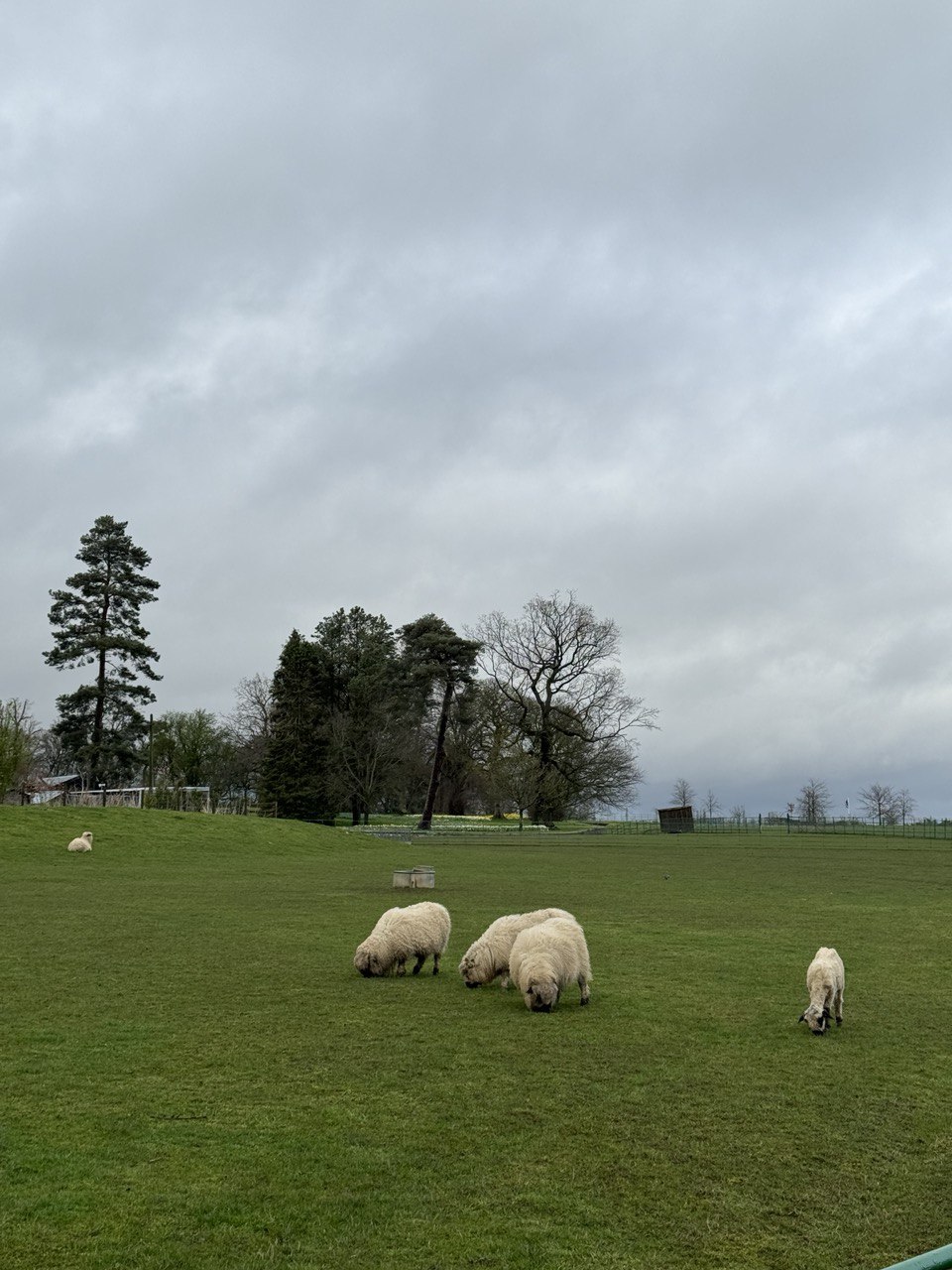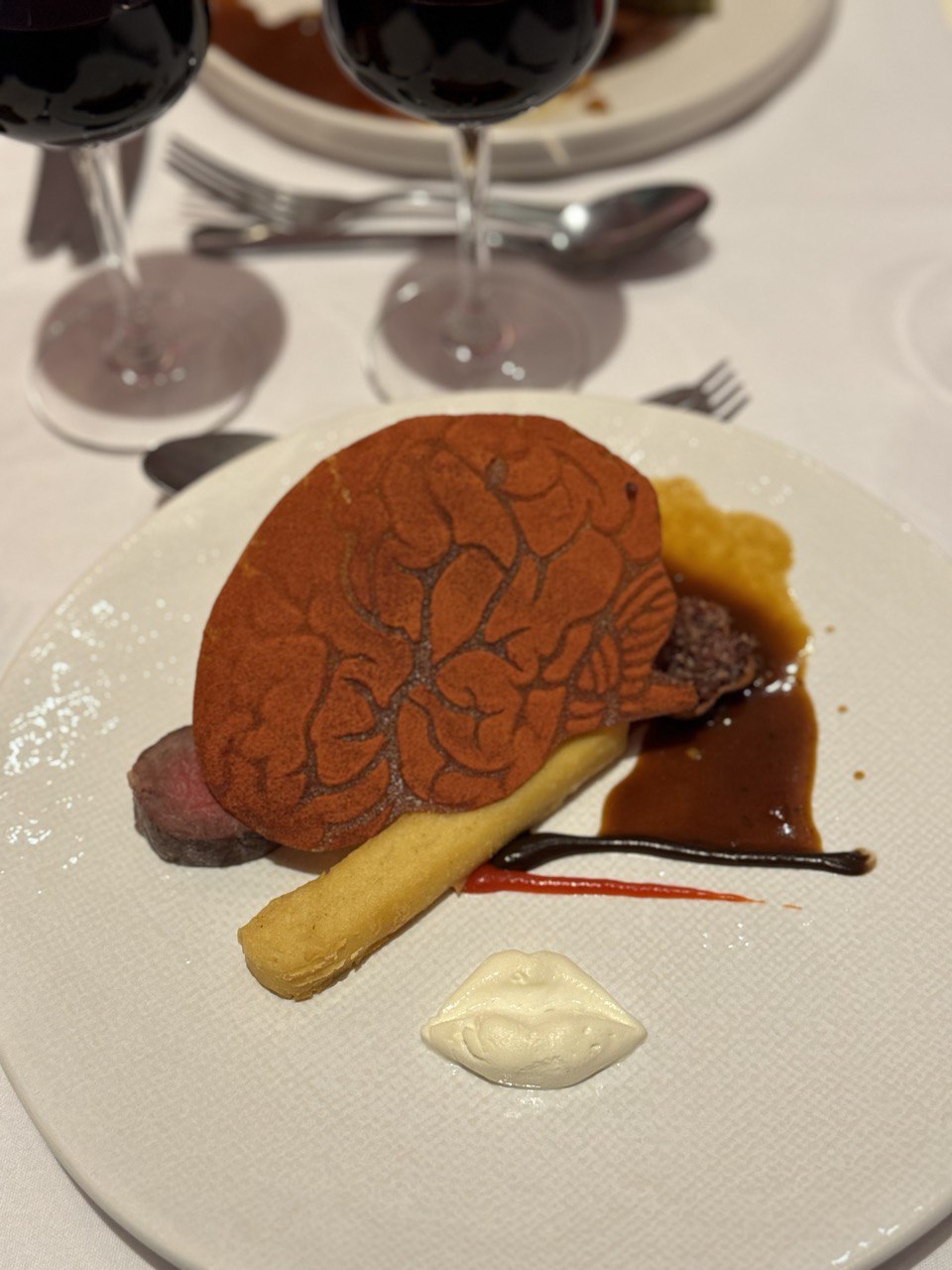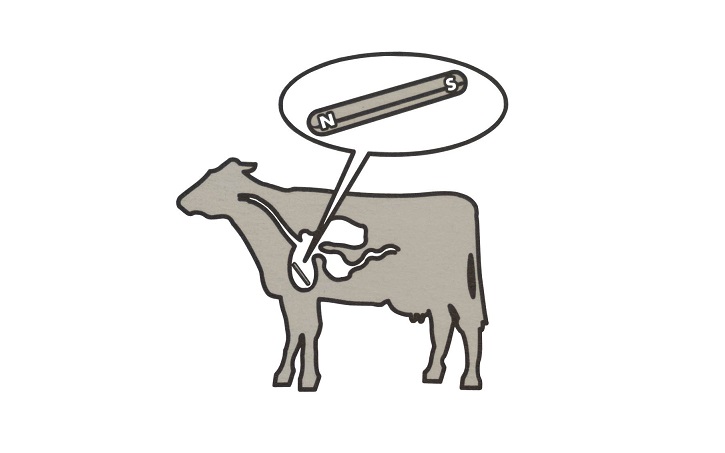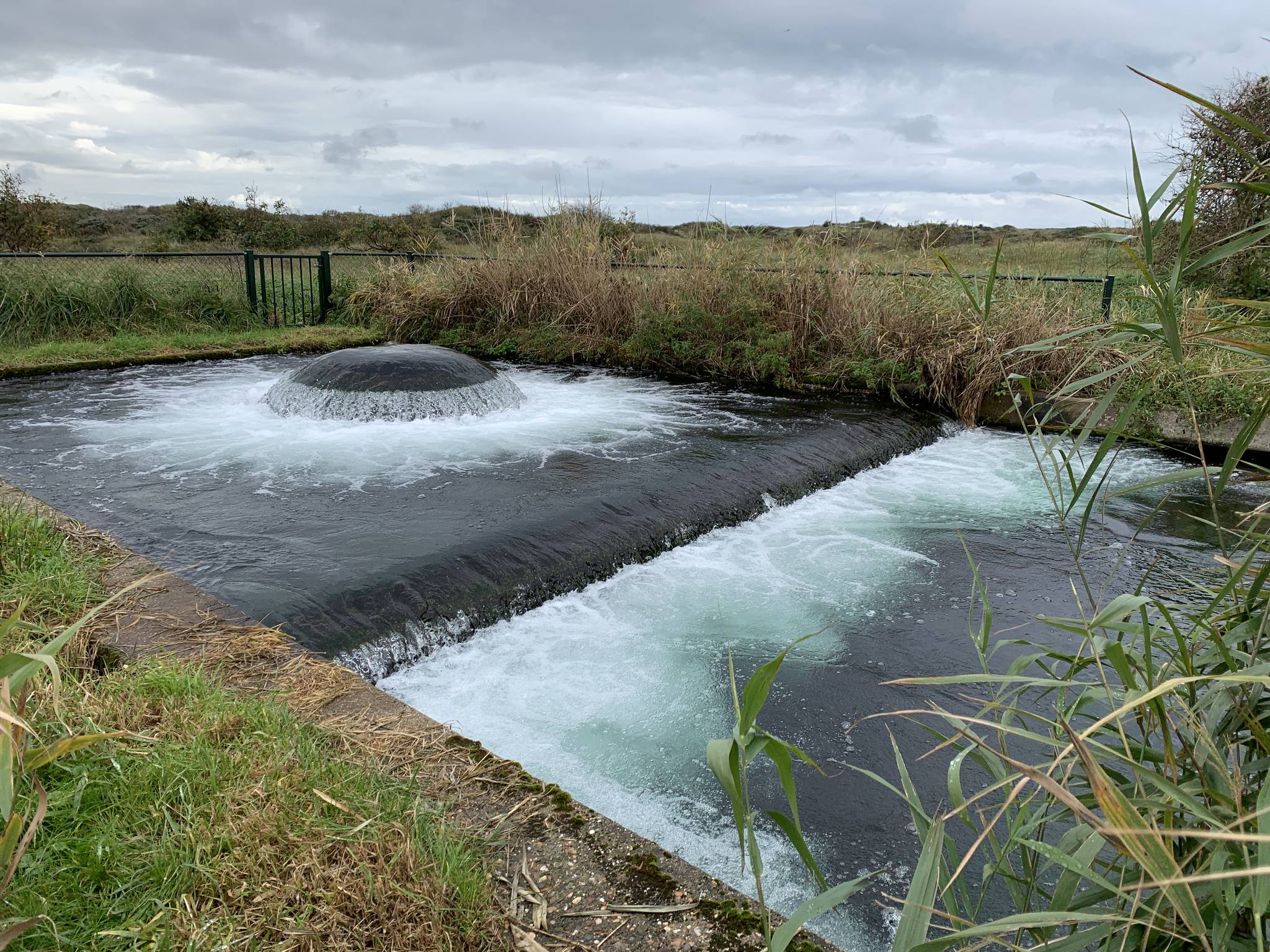#196
On turning 29
I got older this week, and yet didn't have the time to reflect on it properly yet.
To be fair, I doubt I will.
Years back I used every opportunity (whether it's a new year, or a birthday, or just Monday) to summarise things I could cross out on my todo lists and annual goals, but these days I don't even bother.
That being said, I do reflect on my weeks as usual, so do check out these sheep:

And here are the same sheep but served as a part of Great British Menu's dinner by one of the Scottish participants of the competition, a few hundred yards from the farm:

A really peculiar place, but as it often happens it was let down by the server while the food was well worth the trip.
And this is a Cedric Grolet-inspired dessert Sasha made for my birthday:

Everything I love in one hazelnut tart shell: caramelised peanuts, caramel sauce, peanut sponge, crunchy peanuts and feuilletine.
Here is to many more desserts in the year ahead 🍸
Enjoying this? Get Tuesday Triage in your inbox every week.
Things I enjoyed reading
1. Oh the Humanity by Benjamin Sandofsky
Many people know the author of this post as a co-founder and developer of Halide, one of the most powerful iOS camera apps, but this post is not about pictures or iOS specifically, as it talks about the future of personal devices and a company that will eventually disrupt the industry the way Apple did almost twenty years ago.
Despite all its quirks, Humane might have worked out it followed a traditional VC startup formula. Instead, they tried to follow The Apple Way, where 1.0 products need to be so insanely polished as to blow everyone people away.
That approach makes sense for Apple. At minimum, they have a reputation to keep up. Sometimes the Apple Way leads to incredible products, like the first iPhone. Sometimes it doesn't work so well, in the case of the Apple Watch, Imran's final project at the company.
I am slightly sad Humane's AI pin didn't work the way it was promised, even though I couldn't imagine myself using it (yet?).
Change is always a great thing, and it's refreshing to see companies trying to think outside the box, but seems like it takes more than a hefty investment to deliver on these promises.
2. The Surprisingly Long History of the Movement to Make Buildings Safer for Birds by Melissa Breyer
I remember how during my first (and only, ha!) visit to New York I got overwhelmed by all the skyscrapers around: I've seen tall buildings before, but they were always an exception, not a norm. I never thought how it might affect birds though:
Early reports of avian collisions in North America date back to oil-fueled lighthouses in use well before the advent of electricity. But when Thomas Edison famously electrified lower Manhattan with incandescent bulbs in 1882, he sealed a grim fate. Four years later, the Statue of Liberty opened and began operating as the country’s first electric lighthouse. Her illuminated torch, poised 305 feet above sea level, was a beacon for passing ships and a lure for passing birds. For years, reports poured in of disoriented birds that either collapsed from exhaustion or collided with the structure (including the mass-collision event my friend had sent me).
I guess the main highlight for me here is that it's not the issue of exceptionally tall buildings, or the fact that we use way more steel and reflective glass in modern construction, as birds were disoriented even centuries ago. It doesn't mean we shouldn't strive for safer environments though.
3. Software Development 450 Words Per Minute by Tuukka Ojala
This is a very inspirational post by a blind software developer, and I do appreciate the author's sense of humour throughout it:
“Something’s a little bit off here.” That’s what I predict your first thought to be upon seeing my cubicle for the first time. There’s no screen or mouse in sight. Instead there’s a guy hammering away on a keyboard, staring at seemingly nothing.
I wonder how much harder it was in the industry mere twenty years ago, when all these helper apps, like screen readers, were nowhere near as good.
4. Orange Steam Funnels Are a New York Symbol. What Are They For? by Patrick McGeehan
And getting back to New York, I don't really remember the steam tunnels, but I do think I've seen them in movies from time to time. The whole post was a rollercoaster of emotions for me though (what, people produce steam commercially?! What, someone buys steam?! What, they deliver steam across the city?!):
Most of the steam is purchased by owners of commercial and residential buildings, including Madison Square Garden, the Chrysler Building and the World Trade Center. The 9/11 Memorial & Museum uses steam to keep its reflecting pools from freezing, Mr. Cuomo said.
The rest goes to hospitals, hotels, schools, churches and museums. They use it for heating water, air conditioning and humidification.
Are there any other cities in the world that do the same? I have no idea, but Wikipedia seems to be oddly calm about the fact that 8 million people indirectly buy and sell steam to heat their water.
5. Generative UI and Outcome-Oriented Design by Kate Moran and Sarah Gibbons
It's been slightly more than a year since generative AI and LLMs became somewhat mainstream, and yet there are not that many unexpected usecase: creative writing is dying out, people try to use AI as coaches and therapists (with questionable results), and some blog posts have disturbingly redundant AI-generated images. This is probably one of the very few cases where I personally got quite excited by seeing the words "AI":
Generative AI systems have established a new interaction paradigm, intent-based outcome specification. This is already shifting how we think about digital design.
UX design has traditionally involved a heavy focus on the interface. While interfaces will always be important to UX design, AI-powered automation and generative UI will lead to a rise in outcome-oriented design.
Generating design based on users' behaviour is not a new thing, obviously, but up until now it was mostly restricted to very simple presets (think Dark Mode or hidden side bar). Design is just a language though, with its own alphabet, words (components) and sentences (frames), so generating new screens one day would be as simple as getting rhymed lazagna recipes from ChatGPT.
6. Why the “Eisenhower matrix” is a fantastic productivity hack by Kevin Dickinson
I wrote about Eisenhower matrix before – and I used it metodically over years, long enough to make the decisions subconsciously. This is a great overview of its main benefits if you didn't have a chance to read more about the matrix before, or a great way to refresh your memory:
For this reason, it’s best to revisit the Eisenhower matrix from time to time. Some people will find it handy for creating daily or weekly to-do lists. Others will use it during yearly or quarterly reviews. Still others only in times when they need to reaffirm that their values and efforts are lining up.
Whatever your preferred cadence, remember that time management is a moving target. The things that are important to us can and do change. Eisenhower himself had very different goals and responsibilities at different times in his career. The point isn’t to dedicate yourself to optimizing every day to timekeeper perfection. It’s to ensure that you don’t lose sight of your values and goals amid the chaos.
The only problem to me always boils down to delegation of some tasks. It's not hard to decide which tasks to delegate, but finding the right people to delegate to is more complicated.
7. ‘Trademark bully’: Momofuku turns up heat on others selling ‘chili crunch’ by Nina Roberts
That's just a sad but cautionary tale, really: David Chang, a great chef who's memoirs I highly recommended last year, decided to force small brands selling chili oil, a staple in the cuisine, to stop using his new trademark.
Two of the biggest brands, Fly By Jing Sichuan Chili Crisp, launched by entrepreneur and chef Jing Gao in 2018, and China’s condiment queen, Lao Gan Ma Spicy Chili Crisp, are not in Momofuku’s crosshairs because they use “chili crisp”, not “chili crunch”. But those who chose “crunch” over “crisp” or “oil” for their product, are incensed.
As word spread of Momofuku’s cease-and-desist letters among food entrepreneurs making the chili condiment, reactions ranged from fear and annoyance, to disappointment and astonishment at the gall.
The most disappointing part to me is that Chang himself build his whole business on the contrast with corporations, on starting from scratch and cooking simple things well.
He obviously made a U-turn pretty much instantly, but the damage is done.
8. Dungeons & Dragons All Started In This Tiny Wisconsin Town by Tea Krulos
I am still quite far from giving the offline version of D&D a try, and even didn't have the chance to finish my first attempt at Baldur's Gate 3, but I had no idea the game comes from a small town in the middle of nowhere and the only reason it's still around is incredible perseverance of a few people:
As demand grew, Tactical Studies Rules rapidly expanded their real-world kingdom. At their peak in the early 1980s, TSR employed about 400 people, importing writers, artists, and editors to Lake Geneva, a town of less than 6,000 at the time. Although D&D was always their best seller, TSR made other games and had a publishing arm that printed fantasy novels set in D&D realms, and Dragon, a magazine that featured gaming tips and short fiction.
Reading through the story, it makes me think about Apple a lot, as many milestones were very similar.
9. A town employee quietly lowered the fluoride in water for years by The Associated Press
This is another story about a small town, but this one is not as exciting albeit still rather mind-blowing:
Katie Mather, who lives in Richmond, a town of about 4,100 in northwestern Vermont, said at a water commission meeting this week that her dentist recently found her two kids' first cavities. She acknowledged they eat a lot of sugar, but noted that her dentist recommended against supplemental fluoride because the town's water should be doing the trick.
Someone working for the council was slowly reducing fluoride in water over years, and people noticed it quite late. I am not sur about regulations in the States, but here in the UK water everywhere is tested every month, and all reports are public, so you can see the full analysis by typing your postcode.
I use it from time to time to re-calibrate my pH meter or dial in my coffee machine.
10. 28 deaths at a California skydiving center, but the jumps go on by Andrew Chamings
And while this article is quite grim, this is an interesting overview of the state of skydiving pretty much everywhere in the world. Despite being more dangerous than many sports, the industry is not really regulated much, and it doesn't take more than a few hours between signing the waiver and boarding a plane:
FAA inspections have documented a plethora of code violations over the years, particularly around maintenance. In 2009, an inspector found numerous problems with both plane safety and record-keeping, leading a concerned official to write that aircraft maintenance at the Parachute Center “seems to be secondary,” and that Dause’s priority was getting planes in the sky. The inspector wrote that a mechanic at the center was “clearly overwhelmed” by the requirements of keeping four planes airworthy. In 2010, an inspector again found a large number of safety concerns, including a plane which Dause had allegedly damaged by cutting 38 holes out of the rear bulkhead to “allow airflow.”
What's interesting is that most incidents were caused by maintenance issues, so they're avoidable, it's not like first-timers are pulling wrong cords or jumping out without a parachute.
Did you know I make apps?

Silk
Track patterns in your intimate life without judgment. Partner profiles, health insights, and analytics — all encrypted and hidden behind a calculator.
Take a look →Things I didn't know last Tuesday
1. 4,400 Preserved Brains
Imagine putting this on your CV:
She’s now helped research the mechanism of preservation for the 4,400 brains analyzed in the study. Morton-Hayward compares the texture of the brains to tofu. They’re often wet and mushy, all different colors from bright orange to black, and about five times smaller than the average size of a living brain. In some more understandable cases, the brains are preserved with the entire body due to the environmental surroundings; but in other cases, the brains were the only internal organ to survive.
There are a few pictures in the post as well, but now I am curious too how come there are 4k brains in someone's collection that somehow managed to preserve throughout centuries.
2. Naismith's rule
Whenever we go for a hike, we pick an ambitious route just to scale it down fearing that we won't have enough time. Fear no more: there is a rule to calculate the time taking the elevation into account:
Naismith's rule helps with the planning of a walking or hiking expedition by calculating how long it will take to travel the intended route, including any extra time taken when walking uphill. This rule of thumb was devised by William W. Naismith, a Scottish mountaineer, in 1892.
In other words, every 5 km forward will cost you an hour, plus an additional hour for every 600 m up.
3. De Kwal
This could have been a piece of art in a Modern Art museum:
The shape of the water flowing out of this injection point, has given it its nickname, De Kwal (Dutch for “the jellyfish”).
Water injected here stays in the dunes for about three weeks, it creeps slowly through the filtering sands, after which it is pumped up again in one of the almost 700 wells in these dunes. Pathogens such as viruses and bacteria do not survive this stay and are effectively killed off. Only a last filtration step is required to remove excess calcium and iron from the water before it is pumped to the end user as safe and reliable drinking water.
I also quite like the name.
4. Many states in America ban a few varieties of pear trees
I feel like this week's edition is oddly American-centric, but it is what it is:
Bradford pear trees, which can help spread wild, thorny Callery pear trees, are becoming a target of forestry and conservation officials in Kansas, Missouri, Virginia and across the U.S.
How come they're being banned? For years Bradford pear trees seemed like a perfect tree for build-up areas: lots of flours, sterile, grow with decent speed, but years of selection in attempts to make them more sturdy ended up in a varieties that cross-pollinate with Callery pear treas, an invasive species, so now it's a big problem.
5. Cow magnet
Here I learnt two things: first, cows have something commonly called a hardware disease, that is, a disease caused by eating sharp metallic objects, like nails. Second, the solution to it is incredibly straightforward:
A rancher or dairy farmer feeds a magnet to each calf at branding time; the magnet settles in the rumen or reticulum and remains there for the life of the animal. The magnet is administered after fasting the cow for 18–24 hours. This is most effective if done to the entire herd before the age of one.

Now I am pretty sure it was invented by a software engineer.
6. Tempest (codename)
Here in the UK there are myths about TV License companies detecting that someone is watching TV via some devices in their vans, and while I was always incredibly sceptical, in theory that could have been possible given lots of successful research on the topic:
TEMPEST is a U.S. National Security Agency specification and a NATO certification referring to spying on information systems through leaking emanations, including unintentional radio or electrical signals, sounds, and vibrations. TEMPEST covers both methods to spy upon others and how to shield equipment against such spying.
What are the chances though BBC would bother with that? Probably zero.
7. Exposure therapy for arachnophobia can benefit unrelated fears
The article leaves out lots of details but this is pretty cool:
Exposure therapy, where people are gradually exposed to what they’re afraid of in a controlled way, is the best treatment we have, teaching the brain that the feared thing is no longer a threat. This therapy doesn’t just reduce fear of the specific thing it’s aimed at but can also lessen fear of other, similar things. For example, treating a fear of spiders might also reduce a fear of cockroaches.
I am not particularly fond of bees, or height, or crunchy onions in my pasta, but I doubt I'd be keen on getting the exposure therapy to get rid of these fears. Imagine being locked with a room full of onions.
8. Carbondale, Illinois
I love conspiracy theories about certain inevitable events, like the end of the world, as they make for hilarious stories once the chance for an event passes:
If you lived forever, and you never moved from where you are today, on average, you would have to wait 400 years for a total eclipse to come across where you are,” says Frank Close, Professor of Physics at Oxford University and a Fellow of Exeter College. The likelihood that you could experience two total solar eclipses in one place in the space of seven years is miniscule. The chances are so low, that some believe something special is going on in Carbondale. In particular, conspiracy theorists believe that a seismic event will be triggered when the eclipse arrives in this part of the state, known as Little Egypt, killing hundreds of thousands of people.
That's probably the most hilarious story I've seen in a while though, and reasoning is particularly fun. Also I am quite gutted we've missed the eclipse despite Scotland being the only place in the UK where it was meant to be partly visible (alas, clouds).
9. IDP versions
I knew one needs an international driving permit to drive in most countries, but I thought it's just a driving license translated into English. It's not:
You may need an international driving permit (IDP) to drive in some countries [...] There are 3 types of IDP: 1926, 1949, 1968.
The three types are related to pieces of legislations countries signed up to, so some were members of the convention since 1926, while some only since 1968.
That's really odd is that IDP are valid only for 1 year, unless it's the 1968 one (which is valid for 3 years).
10. Little Sparta
The GBM dinner I mentioned earlier took place at Jupiter Artland, which is like a weird art park with odd sculptures hidden between trees, but apparently there are more parks like that in Scotland:
Little Sparta is a garden at Dunsyre in the Pentland Hills in South Lanarkshire, Scotland, created by artist and poet Ian Hamilton Finlay and his wife Sue Finlay, since 1966.

What's with the name, you might ask? It was chosen by the owner in response to Edinburgh's nickname, the "Athens of the North", and highlights the historical rivalry between Athens and Sparta.
See, I didn't waste my time playing Assassin's Creed.
Book of the week
I came across this week's book at a book fair in a village we've visited last summer: apparently it was selected as a book of the year in Scotland, altough seems like in 2022.
That's not a surprise, given Murray Pittock gave it a modest name Scotland: The Global History. What is the surprise is how academic this book reads, comparing to something that I thought would be similarly styled, namely James Hawes's The Shortest History of England, which was the last proper history-related book I've read (almost three years ago):
The Scotland of this study articulated itself distinctly in terms of its foundation myth and national story and its literary relationship to the classical and European generic and canonical traditions. It inflected and interpreted external influences – Dutch, French, English – towards its own specific conditions, and its people articulated themselves in national terms wherever they were in the world, performing identity in diaspora. This was a Scottish identity, for despite the lure of Romanticism and incessant Victorian racializing of British and global experience, Scotland was not a ‘Highland’ nation made up of a ‘clan system’ combined with a Germanic Lowland polity more akin to the English. This in itself was a story – now fading – which grew out of one particular strand of Enlightenment thinking, and which remains in popular consciousness to this day: its legacy can, to an extent, be seen in the category of the ‘Highlands’ as a concept where geographical, linguistic and ethnic grounds are blurred. This is the last redoubt of the racialized Scotland of the Victorian era, long left behind by genetics and a more integrated understanding of Scottish history and culture. ‘Lowland’ and ‘Highland’ are almost ineradicable categories in describing Scotland, but they obscure its history in a misleading simplification which presents geography as a shorthand for culture.
The accolades and reviews made me think this book will be an easy ride through the last few hundred years or so of Scottish history, but the author did his best to highlight how differents people here are comparing to the Southerners, and at some point it required lots of historical references, names, and dates.
I picked up this book trying to better understand the people that live around me – same reason I read the History of England back then – but my main takeaway is probably that Scots are way closer to Europe than they're to England, so not a surprise there is so much effort put into independance attempts.
I also quite enjoyed the last chapter, which cover the most recent few decades of history, and try to explain how Brexit (but not only) prompted political parties to seek for more independence opportunities.
All that being said, I don't think I got to understand people I meet on daily basis better, but I definitely got a better grasp for the island's geopolitical issues of the past few centuries.
Now back to cookbooks.
Thank you and see you in a week
(or in a month)!
If you'd like to support the newsletter, please subscribe to the weekly plan. Otherwise you will keep receiving the letters on a monthly cadence – no need to do anything to opt-in.
If you have any questions, or want to suggest a link for the next newsletter, please drop me a message on Twitter or reply to this email.
Cheers! 🍸
Need help with iOS?
I spent a decade on FDA-regulated medical devices and apps with millions of users. Now I help teams ship MVPs, rescue messy architectures, and build the hard bits that don't fit in a sprint.
Learn more →